Declension (German) | Learn German (Hallo Deutsch 2) - Class 6 PDF Download
| Table of contents |

|
| The Four Cases |

|
| Noun Declension |

|
| Pronoun Declension |

|
| Adjective Declension |

|
The Four Cases
Introduction
In German grammar, understanding cases is crucial because they determine the role of nouns and pronouns in a sentence. There are four cases:
- Nominative (Nominativ): This is the subject case, used for the noun or pronoun that is performing the action. For example, “Der Hund” (The dog) is in the nominative case in “Der Hund bellt” (The dog barks).
- Accusative (Akkusativ): This is the direct object case, used for the noun or pronoun that is directly receiving the action. For example, “Den Hund” (The dog) is in the accusative case in “Ich sehe den Hund” (I see the dog).
- Dative (Dativ): This is the indirect object case, used for the noun or pronoun that is indirectly affected by the action. For example, “Dem Hund” (To the dog) is in the dative case in “Ich gebe dem Hund ein Leckerli” (I give the dog a treat).
- Genitive (Genitiv): This is the possessive case, used to show ownership or relationships. For example, “Des Hundes” (Of the dog) is in the genitive case in “Das ist das Spielzeug des Hundes” (That is the toy of the dog).
Each case has a specific function and is identified by the endings of the articles and the nouns themselves. Recognizing these cases and their roles is the first step in mastering German declension.
Identifying Cases
To correctly use German cases, it’s important to identify them in context. Here’s how you can distinguish each case:
- Nominative (Nominativ): Look for the subject of the sentence, which is usually the doer of the action. It answers the question “Wer oder was?” (Who or what?).
For example: “Der Hund bellt.” (The dog barks.) - “Der Hund” is the subject. - Accusative (Akkusativ): Identify the direct object, which receives the action directly. It answers the question “Wen oder was?” (Whom or what?).
For example: “Ich sehe den Hund.” (I see the dog.) - “den Hund” is the direct object. - Dative (Dativ): Look for the indirect object, which is usually the recipient of the direct object. It answers the question “Wem oder was?” (To whom or what?).
For example: “Ich gebe dem Hund das Futter.” (I give the dog the food.) - “dem Hund” is the indirect object. - Genitive (Genitiv): This case often shows possession and answers the question “Wessen?” (Whose?). It is becoming less common in spoken German but is still used in written German.
For example: “Das ist das Spielzeug des Hundes.” (That is the dog’s toy.) - “des Hundes” shows possession.
Importance of Declension
In German, as in many other languages, the endings of nouns, pronouns, and adjectives change according to their grammatical role in a sentence. This process is known as declension. Here’s why declension is so important:
- Agreement with Grammatical Role: Each case (Nominative, Accusative, Dative, Genitive) serves a different function in a sentence. The endings of words change to reflect these roles. For example, the definite article “the” can be “der” (Nominative masculine), “den” (Accusative masculine), “dem” (Dative masculine), or “des” (Genitive masculine). This change signals the word’s function to the listener or reader.
- Clarity of Communication: Proper declension is essential for clear communication. Incorrect declension can lead to misunderstandings. For instance, “Ich sehe den Hund” (I see the dog) is clear, but “Ich sehe der Hund” would be confusing because “der” is not the correct accusative form for a masculine noun.
- Grammatical Correctness: Using the correct declension is a sign of grammatical proficiency. It shows a deep understanding of the language structure and is crucial for writing and speaking German correctly.
Three types of Declension
- Noun Declension
- Pronoun Declension
- Adjective Declension:
Noun Declension
The declension of nouns in German is a systematic way to change the form of a noun to indicate its case, number (singular or plural), and gender (masculine, feminine, neuter). This path will guide you through the complexities of noun declension.
Noun Genders
In German, every noun has a gender. There are three grammatical genders:
- Masculine (der): Many masculine nouns are agents (people doing things), occupations, days, months, and weather phenomena. For example, “der Mann” (the man), “der Lehrer” (the teacher), “der Montag” (Monday).
- Feminine (die): Feminine nouns include many names for females, occupations, and nouns ending in -ung, -schaft, -keit, -heit, -ion, -tät, -ik. For example, “die Frau” (the woman), “die Freiheit” (freedom), “die Nation” (nation).
- Neuter (das): Neuter nouns often include inanimate objects, metals, elements, young animals, and infants. For example, “das Buch” (the book), “das Eisen” (iron), “das Kätzchen” (kitten).
Declension Tables
Declension tables are essential tools for understanding how German nouns change form based on their case, gender, and number. Here’s a simplified overview of how declension works for nouns:
Singular Nouns
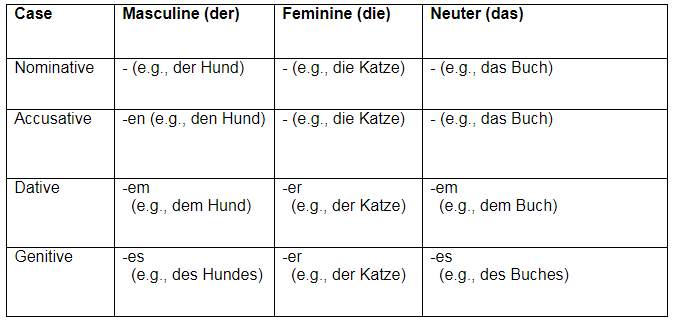
Plural Nouns
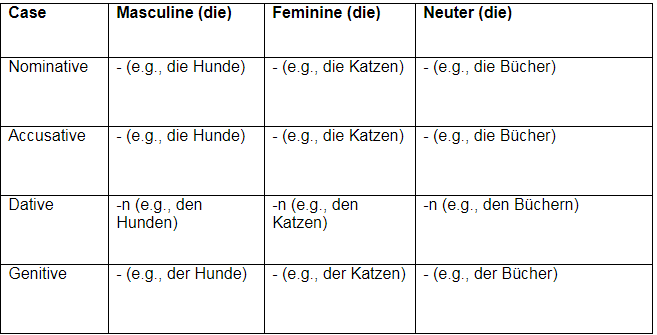
Note that in the plural, all genders use “die” as the definite article in the nominative and accusative cases, and “den” in the dative when an ending is added to the noun.
Learning the Endings
Learning the endings for German noun declension is a key step in mastering the language. Here’s how you can categorize and memorize these endings:
Masculine Nouns
Singular:
- Nominative: usually no ending (e.g., der Hund)
- Accusative: -en (e.g., den Hund)
- Dative: -em (e.g., dem Hund)
- Genitive: -es (e.g., des Hundes)
Plural:
- All cases: often -e or -er (e.g., die Hunde, der Hunde)
Feminine Nouns
Singular:
- All cases: usually no ending (e.g., die Frau, der Frau)
Plural:
- Nominative/Accusative: no ending (e.g., die Frauen)
- Dative: -n (e.g., den Frauen)
- Genitive: - (e.g., der Frauen)
Neuter Nouns
Singular:
- Nominative/Accusative: usually no ending (e.g., das Kind)
- Dative: -em (e.g., dem Kind)
- Genitive: -es (e.g., des Kindes)
Plural:
- All cases: often -er or -e (e.g., die Kinder, der Kinder)
Pronoun Declension
The declension of pronouns in German involves changing the form of pronouns to match their case, gender, and number. This path will guide you through the process of understanding and using pronoun declension effectively.
Types of Pronouns
German pronouns are categorized based on their function and usage. Here are the main types:
- Personal Pronouns (Persönliche Pronomen): Refer to specific persons or things. For example, “ich” (I), “du” (you), “er” (he), “sie” (she/they), “es” (it).
- Possessive Pronouns (Besitzanzeigende Pronomen): Indicate possession or ownership. For example, “mein” (my), “dein” (your), “sein” (his), “ihr” (her/their).
- Demonstrative Pronouns (Demonstrativpronomen): Point out specific items. For example, “dieser” (this), “jener” (that).
- Relative Pronouns (Relativpronomen): Introduce relative clauses. For example, “der” (who/which), “die” (who/which), “das” (which).
- Reflexive Pronouns (Reflexivpronomen): Refer back to the subject of the sentence. For example, “sich” (oneself).
- Interrogative Pronouns (Interrogativpronomen): Used to ask questions. For example, “wer?” (who?), “was?” (what?).
- Indefinite Pronouns (Indefinitpronomen): Refer to non-specific items. For example, “man” (one), “etwas” (something), “niemand” (nobody).
Understanding these categories is essential as each type of pronoun has its own declension patterns.
Declension Tables for Pronouns
Declension tables for pronouns in German provide a clear structure for understanding how different types of pronouns change according to case. Here’s a simplified overview focusing on personal and possessive pronouns:
Personal Pronouns
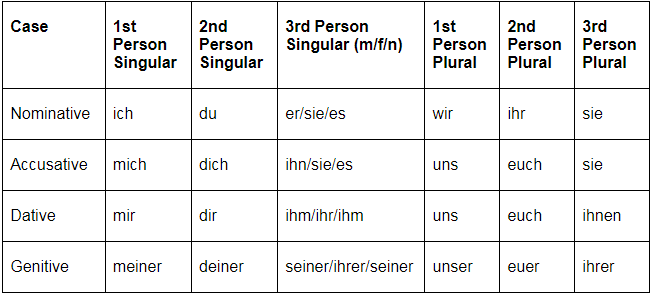
Possessive Pronouns
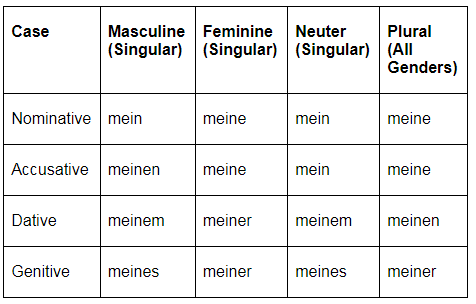
Note: The tables above show the declension for the first person singular possessive pronoun “mein” (my). Other possessive pronouns follow a similar pattern.
Examples
Personal Pronouns
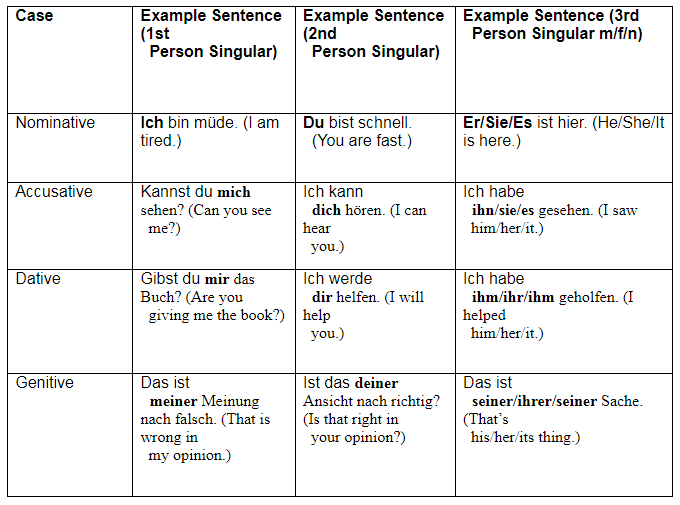
Possessive Pronouns
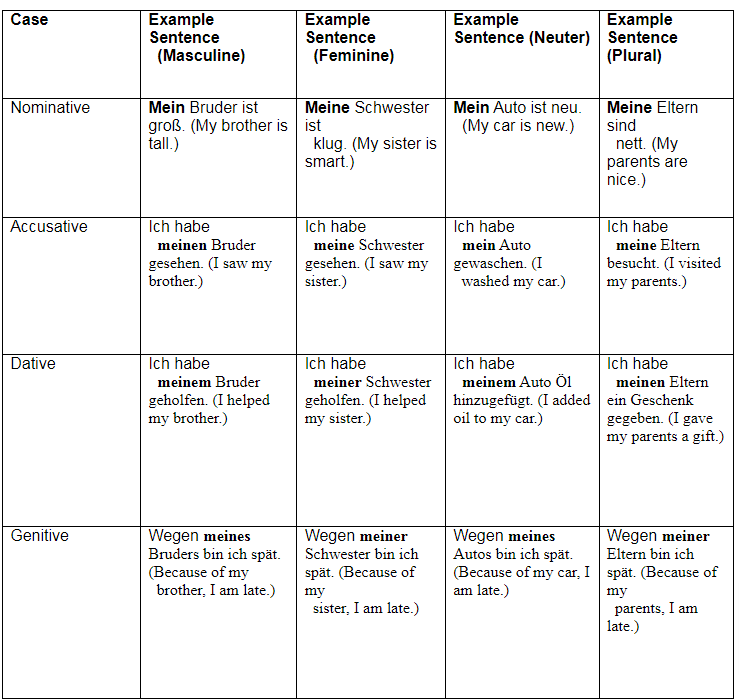
Learning the Endings
Learning the endings for pronoun declension in German is crucial for proper grammar. Here’s how to approach it:
Personal Pronouns:
Personal pronouns change their form based on the case they are in. Here are the endings for each case:
- Nominative: No ending (e.g., ich, du, er, sie, es)
- Accusative: -mich, -dich, -ihn/sie/es (e.g., mich, dich, ihn)
- Dative: -mir, -dir, -ihm/ihr/ihm (e.g., mir, dir, ihm)
- Genitive: -meiner, -deiner, -seiner/ihrer/seiner (e.g., meiner, deiner, seiner)
Possessive Pronouns:
Possessive pronouns also change their form, especially when preceding a noun. Here are the endings:
- Nominative: - (e.g., mein, dein, sein)
- Accusative: -en (e.g., meinen, deinen, seinen)
- Dative: -em (e.g., meinem, deinem, seinem)
- Genitive: -es (e.g., meines, deines, seines)
Adjective Declension
Adjective declension in German is the process by which adjectives change their endings to agree with the nouns or pronouns they modify. This agreement is essential for the grammatical accuracy and clarity of communication.
Importance of Agreement
In German, adjectives must agree with the noun or pronoun they modify in three key aspects:
- Case: The adjective takes on an ending that corresponds to the grammatical case of the noun or pronoun (Nominative, Accusative, Dative, or Genitive).
- Gender: The adjective ending changes based on whether the noun or pronoun is masculine, feminine, or neuter.
- Number: The adjective must also reflect whether the noun or pronoun is singular or plural.
This agreement is crucial because it provides clear information about the relationships between words in a sentence. For example, in the phrase “der kleine Hund” (the small dog), the adjective “kleine” agrees with the masculine, singular, nominative case of “Hund.” If the case were dative, the phrase would be “dem kleinen Hund” (to the small dog), with the adjective changing to reflect the dative case.
Declension Tables for Adjectives
In German, adjectives must be declined to agree with the noun they modify in terms of case, gender, and number. The declension of adjectives is more complex than that of nouns because it depends on whether the adjective is preceded by a definite article (der-words), an indefinite article (ein-words), or no article at all.
Here are simplified declension tables for adjectives in all cases, genders, and numbers when preceded by a definite article:
Definite Article (der-words)

When preceded by an indefinite article or possessive pronoun (ein-words), the adjective endings are as follows:
Indefinite Article (ein-words)

And finally, when there is no article before the adjective, the endings are as follows:
No Article
 Examples
Examples
Definite Article (der-words)
- Nominative: Der alte Baum verliert seine Blätter. (The old tree is losing its leaves.)
- Accusative: Ich sehe den alten Baum. (I see the old tree.)
- Dative: Ich sitze neben dem alten Baum. (I am sitting next to the old tree.)
- Genitive: Die Blätter des alten Baumes fallen. (The leaves of the old tree are falling.)
Indefinite Article (ein-words)
- Nominative: Ein kleiner Vogel singt. (A small bird is singing.)
- Accusative: Ich habe einen kleinen Vogel gesehen. (I saw a small bird.)
- Dative: Ich gebe einem kleinen Vogel Futter. (I am giving food to a small bird.)
- Genitive: Das Nest eines kleinen Vogels ist leicht zu übersehen. (The nest of a small bird is easy to overlook.)
No Article
- Nominative: Kluge Schüler lernen schnell. (Smart students learn quickly.)
- Accusative: Ich bewundere kluge Schüler. (I admire smart students.)
- Dative: Ich helfe klugen Schülern. (I help smart students.)
- Genitive: Die Hausaufgaben kluger Schüler sind fehlerfrei. (The homework of smart students is error-free.)
Categorizing Adjective Endings
Adjective endings in German are determined by the gender (masculine, feminine, neuter), number (singular, plural), and case (nominative, accusative, dative, genitive) of the noun they describe. Here’s a closer look at how to categorize these endings:
- Gender: Masculine (der), Feminine (die), Neuter (das)
- Number: Singular, Plural
- Case: Nominative (subject), Accusative (direct object), Dative (indirect object), Genitive (possession)
Examples
Let’s explore some examples that illustrate the declension of adjectives in different contexts:
Definite Articles (with ‘der’ words):
- Nominative Masculine: Der alte Mann liest eine Zeitung. (The old man is reading a newspaper.)
- Dative Feminine: Ich helfe der alten Frau über die Straße. (I am helping the old woman across the street.)
- Accusative Neuter: Ich sehe das alte Gebäude. (I see the old building.)
- Genitive Plural: Die Geschichten der alten Leute sind interessant. (The stories of the old people are interesting.)
Indefinite Articles (with ‘ein’ words):
- Nominative Masculine: Ein junge Mann ging vorbei. (A young man passed by.)
- Dative Feminine: Ich gebe einer jungen Frau einen Rat. (I am giving a young woman advice.)
- Accusative Neuter: Ich kaufe ein junges Pferd. (I am buying a young horse.)
- Genitive Plural: Die Probleme keiner jungen Leute sind zu hören. (The problems of no young people are heard.)
No Articles:
- Nominative Masculine: Starker Wind weht heute. (Strong wind is blowing today.)
- Dative Feminine: Ich folge starker Intuition. (I follow strong intuition.)
- Accusative Neuter: Ich trinke kaltes Wasser. (I drink cold water.)
- Genitive Plural: Die Ankunft neuer Studenten ist bald. (The arrival of new students is soon.)
These endings are categorized into three types: strong, weak, and mixed.
Strong Endings
Strong endings are used when there is no article before the noun or when the article does not provide case, gender, and number information. Here’s a chart for strong endings:
 For example:
For example:
Nominative: “großer Mann” (big man), “große Frau” (big woman), “großes Kind” (big child), “große Kinder” (big children).
Weak Endings
Weak endings are used when the definite article (der, die, das) or a der-word (dieser, jener, welcher, etc.) precedes the noun. The adjective usually takes an “-en” or “-e” ending.
 For example:
For example:
Accusative: “den großen Mann” (the big man), “die große Frau” (the big woman), “das große Kind” (the big child), “die großen Kinder” (the big children).
Mixed Endings
Mixed endings are used when the noun is preceded by an indefinite article (ein, eine) or a possessive pronoun (mein, dein, unser, etc.). The endings are a mix of strong and weak.
 For example:
For example:
Dative: “einem großen Mann” (to a big man), “einer großen Frau” (to a big woman), “einem großen Kind” (to a big child), “meinen großen Kindern” (to my big children).
Here are six types of exercise questions, each with ten questions, designed to cover the overall topic of German declension, excluding comparative and superlative forms:
Type 1: Noun Declension
Fill in the blanks with the correct declension of the noun in parentheses.
- Der __________ (Hund) spielt im Garten.
- Ich habe einen __________ (Brief) erhalten.
- Wir warten auf die Ankunft des __________ (Zug).
- Die Kinder spielen mit dem __________ (Ball).
- Sie spricht oft von ihrem __________ (Bruder).
- Das ist das Auto des __________ (Mann).
- Die Blumen der __________ (Frau) sind schön.
- Ich gebe dem __________ (Kind) ein Geschenk.
- Die Tasche der __________ (Schülerin) ist schwer.
- Erinnerst du dich an den __________ (Sommer)?
Type 2: Pronoun Declension
Choose the correct pronoun to complete the sentence.
- __________ (Ich/Mich) habe Hunger.
- Kannst du __________ (mir/mich) helfen?
- __________ (Wir/Uns) gehen ins Kino.
- Hast du __________ (sie/ihr) gesehen?
- __________ (Er/Ihn) ist mein Freund.
- __________ (Du/Dich) bist sehr nett.
- __________ (Sie/Ihnen) sind spät dran.
- __________ (Ihr/Euch) müsst jetzt gehen.
- __________ (Es/Ihm) geht nicht gut.
- __________ (Sie/Sie) haben gewonnen.
Type 3: Adjective Declension
Fill in the blanks with the correctly declined adjective in parentheses.
- Der __________ (neu) Student kommt aus Berlin.
- Ich kaufe ein __________ (rot) Kleid.
- Sie hat eine __________ (schön) Stimme.
- Das ist ein __________ (interessant) Buch.
- Wir haben einen __________ (lang) Weg vor uns.
- Er trägt einen __________ (alt) Hut.
- Die __________ (jung) Katzen spielen.
- Ich sehe die __________ (hoch) Berge.
- Sie liest ein __________ (spannend) Roman.
- Das __________ (klein) Kind lacht.
Type 4: Mixed Declension
Combine the correct form of the noun, pronoun, and adjective in the sentence.
- __________ (der/den/dem) __________ (alt) __________ (Mann) erzählt eine Geschichte.
- __________ (die/der/den) __________ (jung) __________ (Frau) läuft schnell.
- __________ (das/den/dem) __________ (klein) __________ (Kind) gehört das Spielzeug.
- __________ (die/den/der) __________ (neu) __________ (Lehrer) sind freundlich.
- __________ (ein/einen/einem) __________ (gut) __________ (Freund) kann man vertrauen.
- __________ (mein/meine/meinem) __________ (schön) __________ (Blumen) blühen.
- __________ (ihr/ihre/ihren) __________ (alt) __________ (Eltern) kommen zu Besuch.
- __________ (das/die/den) __________ (groß) __________ (Häuser) sind teuer.
- __________ (ein/eine/einer) __________ (interessant) __________ (Geschichte) wurde erzählt.
- __________ (der/die/das) __________ (lang) __________ (Weg) ist beschwerlich.
Type 5: Case Identification
Identify the case of the underlined word in the sentence.
- Der Hund jagt den Ball.
- Ich helfe dem Mann.
- Das Geschenk ist für die Mutter.
- Wir warten auf den Zug.
- Die Katze schläft auf dem Sofa.
- Das ist das Buch von dem Autor.
- Sie spricht mit der Lehrerin.
- Er geht ohne den Bruder.
- Das Bild von der Frau hängt an der Wand.
- Die Kinder spielen neben dem Haus.
Type 6: Declension in Context
Fill in the blanks with the correct form of the word in parentheses to complete the text.
- Ich gehe mit __________ (mein) __________ (Freund) in die Stadt.
- __________ (Die/Der/Das) __________ (alt) Brücke ist noch stabil.
- Sie hat __________ (ein) __________ (schön) Lied gesungen.
- Wir fahren durch __________ (die) __________ (hoch) Berge.
- Er trägt immer __________ (sein) __________ (alt) Jacke.
- __________ (Die/Der/Das) __________ (jung) Schauspielerin hat Talent.
- __________ (Ein) __________ (gut) Buch kann inspirieren.
- __________ (Mein) __________ (klein) Bruder spielt draußen.
- __________ (Die/Der/Das) __________ (neu) Lehrer kommt morgen.
- __________ (Ihr) __________ (lang) Haar glänzt im Licht.
Here are the answers to the exercise questions provided:
Type 1: Noun Declension
- Hund
- Brief
- Zuges
- Ball
- Bruder
- Mannes
- Frau
- Kind
- Schülerin
- Sommer
Type 2: Pronoun Declension
- Ich
- mir
- Wir
- sie
- Er
- Du
- Sie
- Ihr
- Es
- Sie
Type 3: Adjective Declension
- neue
- rote
- schöne
- interessante
- lange
- alten
- jungen
- hohen
- spannenden
- kleine
Type 4: Mixed Declension
- der alte Mann
- die junge Frau
- dem kleinen Kind
- die neuen Lehrer
- einem guten Freund
- meine schönen Blumen
- ihre alten Eltern
- die großen Häuser
- eine interessante Geschichte
- der lange Weg
Type 5: Case Identification
- Accusative
- Dative
- Dative
- Accusative
- Dative
- Genitive
- Dative
- Accusative
- Genitive
- Dative
Type 6: Declension in Context
- meinem Freund
- Die alte
- ein schönes
- die hohen
- seine alte
- Die junge
- Ein gutes
- Mein kleiner
- Der neue
- Ihr langes
|
58 videos|43 docs|7 tests
|




















